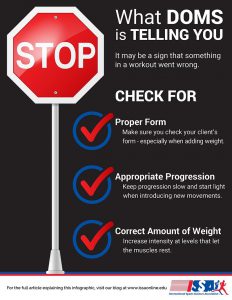By: Andrew Rangel
What is DOMS?
Have you ever wondered why you are feeling really sore a day or two after a workout? What you are experiencing is most likely DOMS or delayed onset muscles soreness. DOMS is not experienced during a workout and could occur between 12 and 24 hours post workout (Ingraham). Those who have trained at a high intensity or have gone straight to training at high intensity rather than gradually working their way to a high intensity have definitely experienced DOMS.
What causes DOMS?
Delayed onset muscle soreness can affect anyone, from a beginner to an advanced athlete or even someone who is not an athlete. Exercise that you are not used to or an intensity that is outside your comfort zone can trigger delayed onset muscle soreness (Olson). These are not the only triggers for DOMS though. Eccentric contractions such bicep curls or the downward motion during a squat can also trigger DOMS (Ingraham). Also, being dehydrated can make DOMS worse than normal which is never good. During high intensity workouts, microscopic tears in your muscle fibers can occur. Increasing inflammation is what your body does in response to this which then may lead to delayed onset muscle soreness (Olson).
Symptoms of delayed onset muscle soreness include muscles that feel tender to the touch, reduced range of motion due to pain and stiffness when moving, swelling in the affected muscles, muscle fatigue, or short-term loss of muscle strength (Olson). Just remember, you do not have to feel sore in order to say you had a good workout. Feeling sore for the next couple of days is not the goal.
Ways to Prevent or Treat DOMS
You may think that laying on the couch or just relaxing taking the day off will help with DOMS. The truth is, doing either of those things will only make the pain worse. An ideal way to continue with your routine is to do light intensity workouts, just as long as the exercises you are doing do not involve so much weight or volume. Some ways that could help reduce the soreness that comes with DOMS includes massage, using a foam roller, cold bath (if you can handle it), warm bath, etc.
DOMS most likely cannot be avoided, but there a few things that can help to lessen the degree of soreness that comes with it. Ways such as staying hydrated, warming up 5-10 minutes before a workout, doing a proper cooldown after a workout along with static stretching, and gradually increasing weight and intensity in your workouts (Olson). It is much better to work your way up step by step rather than jumping from moderate to vigorous intensity within the first month. It is not worth an injury.
References
Paul Ingraham. (n.d.). Post-Exercise, Delayed-Onset Muscle Soreness. Retrieved from https://www.painscience.com/articles/delayed-onset-muscle-soreness.php
Olson, G. (n.d.). Delayed Onset Muscle Soreness (DOMS): Symptoms, Causes, Treatment. Healthline. https://www.healthline.com/health/doms#seeking-help
